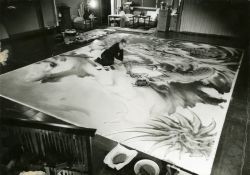

Sakuragawa Himeko made her debut as an Akiba-kei idoru in maid outfit and nekomimi in August 2005, just as the maid boom was in full swing. She’s gained media attention with her single, “Goin’ to Akiba,” and in January 2008 she appeared with the actor Tommy Lee Jones in a BOSS canned coffee commercial set in Akihabara.
PG: Why did you start coming to Akiba?
SH: I always liked games, but it was embarrassing if anyone saw me buying them and called me an otaku. I kind of kept it hidden when I was at school. But when I came to Akiba I found everyone here was like me, so it was OK. It’s my favorite place in the world!
![]() Hanaji (鼻血): Nosebleed. In Japan this signifies someone who is too excited or is thinking sexy thoughts. In anime and manga, if a character gets a nosebleed it’s a sure sign they’re horny.
Hanaji (鼻血): Nosebleed. In Japan this signifies someone who is too excited or is thinking sexy thoughts. In anime and manga, if a character gets a nosebleed it’s a sure sign they’re horny.
![]() Idoru (アイドル): Idol. A highly produced, costumed singer, dancer, or performer who appeals directly to an adoring audience by pandering to their fantasies.
Idoru (アイドル): Idol. A highly produced, costumed singer, dancer, or performer who appeals directly to an adoring audience by pandering to their fantasies.
![]() Joshiryo (女子寮): Girls’ dormitory. A space decorated to look like a girl’s boarding school bedroom that provides the fantasy of entering an all-girls’ sleeping quarters. Female staff dress up in pajamas and are available to play games with in their “rooms.”
Joshiryo (女子寮): Girls’ dormitory. A space decorated to look like a girl’s boarding school bedroom that provides the fantasy of entering an all-girls’ sleeping quarters. Female staff dress up in pajamas and are available to play games with in their “rooms.”
![]() Kegadol (ケガドル): Injured idol. An idoru wearing bandages and an eye patch.
Kegadol (ケガドル): Injured idol. An idoru wearing bandages and an eye patch.
![]() Lolicon (ロリコン): Lolita complex. Derived from Vladimir Nabokov’s 1955 novel Lolita. In Japan, “lolicon” is used to describe either a sexual attraction to young girls or an individual with that desire.
Lolicon (ロリコン): Lolita complex. Derived from Vladimir Nabokov’s 1955 novel Lolita. In Japan, “lolicon” is used to describe either a sexual attraction to young girls or an individual with that desire.
![]()
Maid (メイド): Maids are usually found at cafés in otaku areas such as Akihabara. The different style of costume tends to signify what kind of persona the maid assumes. Girls who wear the classic Victorian style tend to role play as obliging servants and are categorized as iyashi-kei, or soothing style. All others are called moé-kei and are generally girls with colorful, bubbly personalities who act a little like anime characters.
Moé (もえ・萌え): Literally meaning “to bud” (萌える; moéru) and a pun on the homonym “to burn” (燃える; moéru), moé is used among otaku to mean getting fired up for budding young beauties. It can be used as an adjective (e.g., “sore ga moé,” or “that is moé”) or a verb (e.g., “Rei ni moéru,” or “I burn for Rei”). It can further describe moé in, or the moé response to, an object (“Rei-moé,” or “[I] feel moé for Rei”).
![]() Nekomimi (猫耳): Cat ears; especially as costume pieces or charm points on anime and manga characters. Also refers to the sex kittens who wear or have them.
Nekomimi (猫耳): Cat ears; especially as costume pieces or charm points on anime and manga characters. Also refers to the sex kittens who wear or have them.
![]() Oniichan (お兄ちゃん): Big brother. Also the way of choice for some idoru and maids to refer to their close circle of fans.
Oniichan (お兄ちゃん): Big brother. Also the way of choice for some idoru and maids to refer to their close circle of fans.
![]() Panchira (パンチラ): An upskirt or panty shot. Panchira is one of the most common forms of fan service.
Panchira (パンチラ): An upskirt or panty shot. Panchira is one of the most common forms of fan service.
![]() QR Code: Quick Response Code. A type of square barcode popular in Japan. Because they can store URLs, they are ideal for advertising, as viewers can quickly access websites on their mobile phones to get information or discount coupons.
QR Code: Quick Response Code. A type of square barcode popular in Japan. Because they can store URLs, they are ideal for advertising, as viewers can quickly access websites on their mobile phones to get information or discount coupons.
![]() Race Queen (レースクイーン): Promotional motor racing model. They’re usually young girls in their late teens or early twenties, and dress in swimwear, miniskirts, or hot pants, adorned with a company’s logo.
Race Queen (レースクイーン): Promotional motor racing model. They’re usually young girls in their late teens or early twenties, and dress in swimwear, miniskirts, or hot pants, adorned with a company’s logo.
![]() Shitsuji café (執事カフェ): Butler café. Cafés in which staff dress up as butlers. These are the fujoshi answer to maid cafés. Found mostly on otone road in Ikebukuro, Tokyo.
Shitsuji café (執事カフェ): Butler café. Cafés in which staff dress up as butlers. These are the fujoshi answer to maid cafés. Found mostly on otone road in Ikebukuro, Tokyo.
![]() Tsundere (ツンデレ): Word combining the onomatopoeia tsun tsun (which suggests turning your head away in disgust) with dere dere (to turn all lovey dovey). As the literal translation implies, this means characters who’re particularly moody. There are now tsundere events at maid cafés where the waitresses go out of their way to be mean to customers but eventually melt down when they are about to leave.
Tsundere (ツンデレ): Word combining the onomatopoeia tsun tsun (which suggests turning your head away in disgust) with dere dere (to turn all lovey dovey). As the literal translation implies, this means characters who’re particularly moody. There are now tsundere events at maid cafés where the waitresses go out of their way to be mean to customers but eventually melt down when they are about to leave.
![]() United Archives (複合アーカイブ): Code name for a planned “otaku museum” associated with Meiji University and curated by Morikawa Kaichiro of the School of Global Japanese Studies. It will open sometime after 2010. Aside from an art museum and archive space, there will be an anime theater and a hall to host doujinshi events.
United Archives (複合アーカイブ): Code name for a planned “otaku museum” associated with Meiji University and curated by Morikawa Kaichiro of the School of Global Japanese Studies. It will open sometime after 2010. Aside from an art museum and archive space, there will be an anime theater and a hall to host doujinshi events.
![]() Vocaloid (ボーカロイド): A voice synthesizer software developed by Yamaha to allow users to produce singing from their computers by simply typing in lyrics and choosing the melody. “Vocaloid” also refers to the characters created by third party developers to embody the voices included in the software. The most popular vocaloid is Hatsune Miku, a green-haired idoru with pigtails and a leek baton, created by Crypton Future Media.
Vocaloid (ボーカロイド): A voice synthesizer software developed by Yamaha to allow users to produce singing from their computers by simply typing in lyrics and choosing the melody. “Vocaloid” also refers to the characters created by third party developers to embody the voices included in the software. The most popular vocaloid is Hatsune Miku, a green-haired idoru with pigtails and a leek baton, created by Crypton Future Media.
![]() World Cosplay Summit (世界コスプレサミット): An international gathering and tournament for cosplayers held annually since 2003 in Nagoya, Aichi Prefecture. In late 2008, the World Cosplay Championships had teams from thirteen countries and over 12,000 spectators attended, many cosplaying themselves.
World Cosplay Summit (世界コスプレサミット): An international gathering and tournament for cosplayers held annually since 2003 in Nagoya, Aichi Prefecture. In late 2008, the World Cosplay Championships had teams from thirteen countries and over 12,000 spectators attended, many cosplaying themselves.
![]() X JAPAN: One of the earliest examples of Japanese visual-kei rock music. Founded in 1982, they made their debut in 1989 and signed with Sony.
X JAPAN: One of the earliest examples of Japanese visual-kei rock music. Founded in 1982, they made their debut in 1989 and signed with Sony.
![]() Yaoi (ヤオイ): An acronym for no climax (YAma nashi), no punchline (Ochi nashi), and no meaning (Imi nashi). A genre of manga featuring male-male homosexual romance and pornography for heterosexual female readers.
Yaoi (ヤオイ): An acronym for no climax (YAma nashi), no punchline (Ochi nashi), and no meaning (Imi nashi). A genre of manga featuring male-male homosexual romance and pornography for heterosexual female readers.
![]() Zettai ryoiki (絶対領域): The absolute barrier. Also used to describe the stretch of exposed flesh above a girl’s knee-high stockings and below her miniskirt.
Zettai ryoiki (絶対領域): The absolute barrier. Also used to describe the stretch of exposed flesh above a girl’s knee-high stockings and below her miniskirt.

The Otaku Encyclopedia: An insider’s guide to the subculture of Cool Japan. By Patrick W. Galbraith. Foreword by Frederick L. Schodt (Kodansha International, 2009, ¥2,000). Available at bookstores throughout Japan, Amazon Japan





